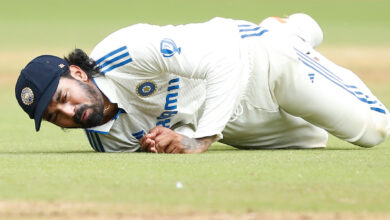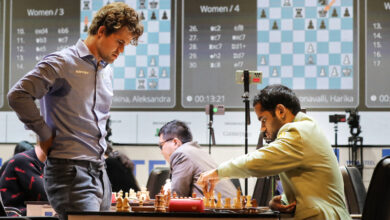1,200 workers, 24×7 shifts, hundreds of crores: Rourkela set for hockey World Cup

When Chief Miner Naveen Patnaik laid the foundation stone for a new hockey stadium at Rourkela on February 16, 2021 — in the middle of a pandemic — and announced that it would be a second venue for the Men’s FIH Hockey World Cup, many, even within the government, were sceptical about its timely completion. So much so that the International Hockey Federation had to give the state a deadline of November 30 to complete the main structure and lay the turf.
For two years since then, over 1,200 migrant workers — many of them from Bihar, Jharkhand and West Bengal — worked round the clock in three shifts to construct the stadium. And less than three weeks before the first match, the grand saucer-shaped steel structure, with a seating capacity of around 21,000, stands tall over 16 acres of land.
A total of 20 matches will be played in the new stadium to be named after freedom fighter and tribal icon Birsa Munda.
The Chief Miner is expected to inaugurate the structure, the country’s biggest hockey stadium, early in January. Along with the Kalinga Stadium in Bhubaneswar, it will host the World Cup from January 13 to 29. A total of 20 matches will be played in the new stadium to be named after freedom fighter and tribal icon Birsa Munda.
At the stadium site, workers continue to toil round the clock to put things together. Though the stadium work has already been completed and the ground was used for a practice match between junior teams of India and South Korea, large cranes have been deployed to fix the aluminium facades and glass windows, and finish other structural work. Some other workers were racing against time to complete roads, lawns, parking lots and other ancillary work on the stadium premises.
Sabarish, the project manager at the site, said they built the stadium in just 15 months as they started the work in August 2021.
“When we started, the patch of land was a jungle with thousands of large trees and bushes, which has now been turned into the country’s largest stadium. We faced several difficulties while carrying out work with Covid regulations. Transportation of materials, especially steels which were transported from Bhilai and the synthetic turfs which were imported from Germany, was also a challenge,” said Sabarish.
A total of 20 matches will be played in the new stadium to be named after freedom fighter and tribal icon Birsa Munda.
The Monsoon rainfall also affected the work for several months.
Around 3,600 tonnes of structural steel and 4,000 tonnes of TMT steel were used to build the stadium. Each seat has been designed to provide an uninterrupted view and spectators will be closer to the pitch than at any other hockey stadium in the world, claimed an engineer without wishing to be named.
The state’s BJD government has not given any official figure on the amount spent for building the stadium at Rourkela. Sports Miner Tusharkanti Behera, in a written reply on November 24, said that a total of Rs 875 crore has been spent for construction of Birsa Munda Hockey Stadium and upgradation of the Kalinga Stadium. An official said over Rs 500 crore has been spent to build the new stadium.
Unlike other cities, players will not have to travel much in Rourkela during the event as their accommodation, practice pitch, main stadium, swimming pool and gym are located in close proximity. The newly developed airport is also adjacent to the stadium.
Considering the limitations in the hospitality sector in the steel city, the Odisha government has developed 225 4-star category rooms, the management of which has been handed over to the Taj Group during the tournament. Over Rs 84 crore has been spent on developing accommodation for players, support staff and officials.
“Of the 225 rooms, we have already completed and handed over 150 rooms to Taj Group. The remaining 75 rooms will be ready the end of this month. The accommodation facility can cater to the needs of at least eight teams at a time. The swimming pool and state-of-the-art gym for players are also ready to use,” said Bhupendra Singh Poonia, managing director of state-owned Idco that oversees the development of stadium and accommodation facilities in Rourkela.
The Sundargarh drict adminration has also reserved over 100 rooms in different government guest houses in the city which will be used during the tournament. The staff quarters of the Biju Patnaik University of Technology have also been upgraded as temporary accommodation facilities.
Stadium construction site. (Express file photo)
The steel city also has around 60 small and big hotels with around 1,500 rooms, which the adminration said can be used visitors and relatives of players coming to watch their teams in action.
In a major connectivity boost to Rourkela ahead of the Hockey World Cup, the Directorate General of Civil Aviation has granted a license to Rourkela Airport for public use. The Steel Authority of India Ltd (SAIL), which owns the airport, has reportedly received permission to operate 72-seater aircraft.
A view of the construction site (Express Photo/File)
Subhankar Mohapatra, Rourkela Additional Drict Magrate, said players will be directly flown to the city chartered flights hired the state government. “For public use, Alliance Air is tentatively to start commercial operation from Bhubaneswar to Rourkela from January first week,” he said.
The adminration has also planned to start a shuttle service for flyers coming to the nearest airport at Jharsuguda, which is a 2.5-hour drive from Rourkela.
Rourkela, the second smart city in Odisha apart from Bhubaneswar, has undergone a massive transformation — wider roads, refurbished pavements, illumination, improved drainage, renovated parks and fountains, gardens and sanitation work.
Panposh sports hostel (Express Photo/File)
To strengthen urban mobility during the event, the state government will introduce a fleet of 25 buses under the city bus project.
The security system and traffic management have been strengthened in the city with the installation of CCTVs. The sculptures and artworks on major city roads also add colour to the beautification of the city while almost all the walls shine with colourful murals of hockey legends, mythological figures and eminent Odia personalities, among others.
All this work was undertaken with funding under the Smart City Mission, said Mahapatra. Locals, however, are apprehensive about its maintenance after the event concludes. “We can see the change on the ground with several projects taken up the adminration. But the challenge will be to maintain these projects after the World Cup,” said Arabinda Patra, a city resident.







